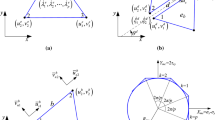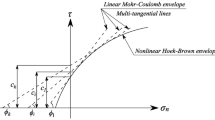Abstract
The study of earth masses requires numerical methods that provide the quantification of the safety factor without requiring detrimental assumptions. For that, equilibrium analysis can perform fast computations but require assumptions that limit its potentiality. Limit analysis does not require detrimental assumptions but are numerically demanding. This work provides a new approach that combines the advantage of both the equilibrium method and the limit analysis. The defined hybrid model allows probabilistic analysis and optimization approaches without the assumption of interslice forces. It is compared with a published case and used to perform probabilistic studies in both a homogeneous and a layered foundation. Analyses show that the shape of the density probability functions is highly relevant when computing the probability of failure, and soil elasticity hardly affects the safety of factor of the earth mass.
Similar content being viewed by others
References
CHOWDHURY R, FLENTJE P, BHATTACHARYA G. Geotechnical slope analysis [M]. London: Taylor and Francis Group, 2010.
GRIFFITHS D, LANE P. Slope stability analysis by finite elements [J]. Géotechnique, 1999, 49(3): 387–403.
LIN H, CAO P, GONG F Q, LI J T, GUI Y L. Directly searching method for slip plane and its influential factors based on critical state of slope [J]. Journal of Central South University of Technology, 2009, 16(1): 131–135.
SHIAU J, MERIFIELD R, LYAMIN A V, SLOAN S W. Undrained stability of footings on slopes [J]. International Journal of Geomechanics, 2011, 11(5): 381–390.
ZHENG Y, TANG X, ZHAO S, DENG C, LEI W. Strength reduction and step-loading finite element approaches in geotechnical engineering [J]. Journal of Rock Mechanics and Geotechnical Engineering, 2009, 1(1): 21–30.
YANG X L, ZHANG D B, WANG Z W. Upper bound solution for supporting pressures of shallow tunnels with nonlinear failure criterion [J]. Journal of Central South University, 2013, 20(7): 2034–2040.
LIU Y R, HE Z, LENG K D, HUANG Y Q, YANG Q. Dynamic limit equilibrium analysis of sliding block for rock slope based on nonlinear FEM [J]. Journal of Central South University, 2013, 20(8): 2263–2274.
ZHOU X P, CHENG H. Analysis of stability of three-dimensional slopes using the rigorous limit equilibrium method [J]. Engineering Geology, 2013, 160: 21–33.
SLOAN S. Lower bound limit analysis using finite elements and linear programming [J]. International Journal for Numerical and Analytical Methods in Geomechanics, 1988, 12(1): 61–77.
JIANG G L, MAGNAN J P. Stability analysis of embankments: Comparison of limit analysis with methods of slices [J]. Géotechnique, 1997, 47(4): 857–872.
MOHAMMADI S, TAIEBAT H. A large deformation analysis for the assessment of failure induced deformations of slopes in strain softening materials [J]. Computers and Geotechnics, 2013, 49: 279–288.
MCCOMBIE P, WILKINSON P. The use of the simple genetic algorithm in finding the critical factor of safety in slope stability analysis [J]. Computers and Geotechnics, 2002, 29(8): 699–714.
HUANG C C. Developing a new slice method for slope displacement analyses [J]. Engineering Geology, 2013, 157: 39–47.
XUE J F, GAVIN K. Simultaneous determination of critical slip surface and reliability index for slopes [J]. Journal of Geotechnical and Geoenvironmental Engineering, 2007, 133(7): 878–886.
CHAI J, IGAYA Y, HINO T, CARTER J. Finite element simulation of an embankment on soft clay: Case study [J]. Computers and Geotechnics, 2013, 48: 117–126.
WANG Y, CAO Z, AU S K. Efficient monte carlo simulation of parameter sensitivity in probabilistic slope stability analysis [J]. Computers and Geotechnics, 2010, 37(7/8): 1015–1022.
JI J, LIAO H, LOW B. Modeling 2-D spatial variation in slope reliability analysis using interpolated autocorrelations [J]. Computers and Geotechnics, 2012, 40: 135–146.
WANG L, HWANH J, LUO Z, JUANG C, XIAO J. Probabilistic back analysis of slope failure: A case study in Taiwan [J]. Computers and Geotechnics, 2013, 51: 12–23.
WANG L, HWANG J, JUANG C, ATAMTURKTUR S. Reliability-based design of rock slopes-A new perspective on design robustness [J]. Engineering Geology, 2013, 154: 56–63.
RUSSELLI C. Probabilistic methods applied to geotechnical engineering [D]. S-Vaihingen: University of Stuttgart, 2008.
PHOON K-K, KULHAWY F-H. Characterization of geotechnical variability [J]. Canadian Geotechnical Journal, 1999, 36(4): 612–624.
HARR M. Reliability-based design in civil engineering [M]. New-York: McGraw-Hill, 1987: 153.
LI K, LUMB P. Probabilistic design of slopes [J]. Canadian Geotechnical Journal, 1987, 24(4): 520–535.
MOORMANN C, KATZENBACH R. Considerations on stochastic methods in soil mechanics for Frankfurt clay [C]// Proceedings in the honour of the 60th anniversary of Prof. Dr. Stephan Semprich, 2003: 255–282.
CUI L, SHENG D. Genetic algorithms in probabilistic finite element analysis of geotechnical problems [J]. Computers and Geotechnics, 2005, 32(8): 555–563.
LI Y C, CHEN Y M, ZHAN T, LING D S, CLEALL P. An efficient approach for locating the critical slip surface in slope stability analyses using a real-coded genetic algorithm [J]. Canadian Geotechnical Journal, 2010, 47(7): 806–820.
GEUZAINE C, REMACLA J-F. Gmsh: A three-dimensional finite element mesh generator with built-in pre- and post-processing facilities [J]. International Journal for Numerical Methods in Engineering, 2009, 79(11): 1309–1331.
USACE. Reliability assessment of navigation structures: Stability assessment of existing gravity structures [R]. Technical Report, US Army Corps of Engineers, 1993.
Author information
Authors and Affiliations
Corresponding author
Rights and permissions
About this article
Cite this article
Araújo, N., Machado, G.J., Martins, J.B. et al. Finite element model with imposed slip surfaces for earth mass safety evaluation. J. Cent. South Univ. 21, 3627–3638 (2014). https://doi.org/10.1007/s11771-014-2345-1
Received:
Accepted:
Published:
Issue Date:
DOI: https://doi.org/10.1007/s11771-014-2345-1




